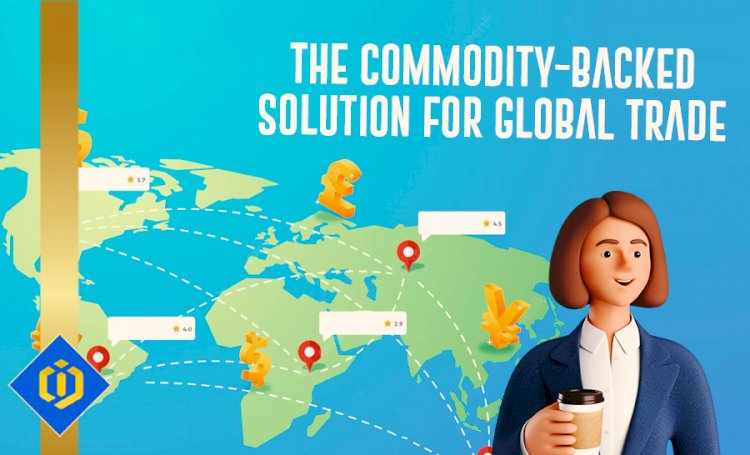A Unifying Global Currency Backed by Commodity

The notion of a global currency
Economists, decision-makers, and futurists have been fascinated by the idea of a single global currency for many years. The main driving force behind this concept is to deal with a number of problems that arise during cross-border transactions, including unstable exchange rates, high transaction costs, and inefficiencies brought on by the requirement to manage multiple national currencies. This cintjournal.com article delves into the background of the concept of a global currency, looking at early proposals and the potential benefits of putting one in place.
When trade goods were replaced by money as the main factor influencing exchange rates at the beginning of the 1970s, the world economy underwent a significant change. This alteration prompted numerous attempts to fix exchange rate issues and stabilize the global monetary system. For instance, governments attempted to change the exchange rate system more than thirty years ago by tightening up control and coordinating efforts. However, they failed to adequately account for the underlying economic policies that influenced exchange rates, which resulted in situations like the October 1987 Black Monday stock market crash. The need for coordinated policymaking and the requirement that governments cede some of their economic sovereignty were both brought home by this disastrous financial event.
Despite differences in national economic policies, cross-border transactions have been made easier by the growing integration of global financial markets. By changing trade revenues and the demand and supply of various currencies, these transactions—which have been made possible by advancements in telecommunications technology—can indirectly affect exchange rates. As a result, the case for having a single currency for all nations grows stronger.
Many economic issues involving exchange rates and currency risks would be automatically resolved by the creation of a universal currency. A global currency would eradicate currency risks and significantly enhance trade, employment, and investment. Additionally, by giving them more access to international markets and financial stability, this new system could help smaller countries with limited economic resources overcome their challenges.
The idea of a global currency is an ambitious and challenging project, but its advantages are undeniable. A single currency could revolutionize international trade and pave the way for a more just and prosperous future for all nations by streamlining global transactions and fostering economic stability.
The creation of commodity-backed tokens
Creating tokens backed by actual commodities, such as precious metals, energy sources, and agricultural products, is a practical way to implement a global payment system. Compared to traditional fiat currencies, these commodity-backed tokens would be more stable and dependable because the value of each token would be intrinsically tied to a specific commodity.
To accomplish this, a global bourse or exchange would be set up where these tokens could be traded and exchanged in accordance with the requirements of the global market. This platform would offer a clear and effective system for valuing and exchanging tokens, guaranteeing that the system stays impartial and impervious to fraud.
The security and effectiveness of this commodity-backed token system could be further improved by the use of blockchain technology. Due to the decentralized and transparent nature of blockchain, there would be less opportunity for fraud and corruption because transactions could be easily tracked and verified.
International trade could be decoupled from the whims of national currencies and the erratic exchange rates that go along with them by using commodity-backed tokens. Instead, a more stable and equitable foundation for the world economy would allow nations and individuals to exchange value based on the actual value of tangible assets.
As nations would be encouraged to safeguard and maintain the value of their commodity reserves, this system would also promote responsible resource management. It would also lessen reliance on any one government or organization, fostering a more stable and democratic global economic environment.
18 Primary Commodities and Precious Metals Constitute the Basis
The foundation of the proposed global monetary system would be composed of 18 principal commodities and precious metals that are necessary for both economic stability and human life. These assets would include, but not be limited to, agricultural products like wheat, corn, and soybeans, energy resources such as oil and natural gas, and precious metals like gold, silver, and platinum.
These 18 goods and precious metals were chosen based on their significance to the world economy, their universal appeal, and their capacity to hold value over time. The global financial system would be more secure, open, and impervious to manipulation if its value was tied to these physical assets.
A direct and simple conversion between tokens and commodities would be possible thanks to commodity-backed tokens, each of which would represent a specific portion of the underlying asset. Through the exchange of value based on the actual value of tangible assets, market participants would be able to lower the risks related to currency devaluation and exchange rate fluctuations.
moving toward a global currency backed by commodities
The introduction of a global currency backed by commodities would represent a significant shift from the current fiat-based system. This new system, which would be advantageous to people, businesses, and governments alike, would promote economic stability, fairness, and transparency by substituting national currencies with tokens backed by actual assets.
A thorough and well-considered implementation plan must be created to ensure a smooth transition to this new global currency. This would entail the development of a regulatory framework to oversee the system, the establishment of an international exchange or bourse for trading tokens backed by commodities, and the creation of technological infrastructure to enable the efficient and secure exchange of tokens.
Countries and individuals would become less dependent on conventional fiat currencies and the risks involved as they gradually adopted the new global currency. With more equitable wealth distribution over time, this change would eventually result in a more balanced and just world economy.
Future prospects for the world economy are greatly enhanced by the idea of a currency backed by commodities. This new system could revolutionize how we exchange value by tying the value of money to tangible assets and utilizing cutting-edge technologies like blockchain, which would promote stability, fairness, and prosperity for all.
Author: Pooyan Ghamari, Swiss Economist

 content-team
content-team 


















